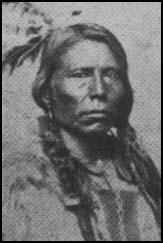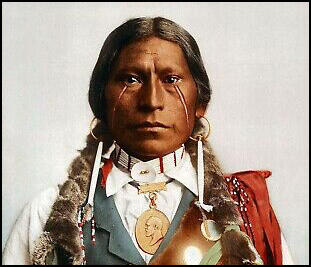Crazy Horse

Crazy Horse was born in about 1840. His father was a medicine man and his mother was the sister of Spotted Tail. A warrior of some distinction he fought with Red Cloud, leader of the Oglala Sioux, during the Indian Wars.
On 21st December, 1866, Captain W. J. Fetterman and an army column of 80 men, were involved in protecting a team taking wood to Fort Phil Kearny. Although under orders not to "engage or pursue Indians" Fetterman gave the orders to attack a group of Sioux warriors. The warriors ran away and drew the soldiers into a clearing surrounded by a much larger force. All the soldiers were killed in what became known as the Fetterman Massacre. Later that day the stripped and mutilated bodies of the soldiers were found by a patrol led by Captain Ten Eyck. Crazy Horse was one of those who took part in this massacre.
Crazy Horse and his men continued to attack soldiers trying to protect the Bozeman Trail. On 2nd August, 1867, several thousand Sioux and Cheyenne attacked a wood-cutting party led by Captain James W. Powell. The soldiers had recently been issued with Springfield rifles and this enabled them to inflict heavy casualties on the warriors. After a battle that lasted four and a half hours, the Native Americans withdrew. Six soldiers died during the fighting and Powell claimed that his men had killed about 60 warriors.
Despite this victory the army was unable to successfully protect the Bozeman Trail and on 4th November, 1868, Red Cloud and 125 chiefs were invited to Fort Laramie to discuss the conflict. As a result of these negotiations the American government withdrew the garrisons protecting the emigrants travelling along the trail to Montana. Red Cloud and his warriors then burnt down the forts.
In December, 1875 the Commissioner of Indian Affairs directed all Sioux bands to enter reservations by the end of January 1876. Sitting Bull, the spiritual leader of his people, refused to leave his hunting grounds. American Horse and Crazy Horse agreed and led his warriors north to join up with Sitting Bull.
In June 1876 Sitting Bull subjected himself to a sun dance. This ritual included fasting and self-torture. During the sun dance Sitting Bull saw a vision of a large number of white soldiers falling from the sky upside down. As a result of this vision he predicted that his people were about to enjoy a great victory.
On 17th June 1876, General George Crook and about 1,000 troops, supported by 300 Crow and Shoshone, fought against 1,500 members of the Sioux and Cheyenne tribes. The battle at Rosebud Creek lasted for over six hours. This was the first time that Native Americans had united together to fight in such large numbers.
General George A. Custer and 655 men were sent out to locate the villages of the Sioux and Cheyenne involved in the battle at Rosebud Creek. An encampment was discovered on the 25th June. It was estimated that it contained about 10,000 men, women and children. Custer assumed the numbers were much less than that and instead of waiting for the main army under General Alfred Terry to arrive, he decided to attack the encampment straight away.

Custer divided his men into three groups. Captain Frederick Benteen was ordered to explore a range of hills five miles from the village. Major Marcus Reno was to attack the encampment from the upper end whereas Custer decided to strike further downstream.
Reno soon discovered he was outnumbered and retreated to the river. He was later joined by Benteen and his men. Custer continued his attack but was easily defeated by about 4,000 warriors. At the battle of the Little Bighorn Custer and all his 264 men were killed. The soldiers under Reno and Benteen were also attacked and 47 of them were killed before they were rescued by the arrival of General Alfred Terry and his army.
The U.S. army now responded by increasing the number of the soldiers in the area. As a result Sitting Bull and his men fled to Canada, whereas Crazy Horse remained in Montana. He continued to lead attacks on settlers but on 22nd April, 1877, Crazy Horse and his followers, including his uncle, Little Hawk, surrendered to General George Crook at the Red Cloud Agency in Nebraska.
On 7th September, 1877, Crazy Horse was invited to a meeting at Fort Robinson. While there he was bayoneted by a soldier named William Gentles. He died later that night.
Primary Sources
(1) Nelson Miles, Personal Recollections and Observations (1896)
Between the years 1869-75 the pressure of advancing civilization was very great upon all sides. The hunters, prospectors, miners, and settlers were trespassing upon the lands granted to the Indians. It was generally believed that the Black Hills country possessed rich mineral deposits, and miners were permitted to prospect for mines. Surveying parties were allowed to traverse the country for routes upon which to construct railways, and even the government sent exploring expeditions into the Black Hills country, that reported evidences of gold fields. All this created great excitement on the part of the white people and a strong desire to occupy that country. At the same time it exasperated the Indians to an intense degree, until disaffection developed into open hostilities.
Spotted Tail was a strong character, a wise and really great chief. He would have been a statesman, diplomatist, or able governor if he had been a white man. Red Cloud had been a noted warrior, but at this time was conservative and diplomatic. Both of these hereditary chiefs remained friendly and counseled peace, but the war spirit prevailed. Crazy Horse was the incarnation of ferocity - a fierce, restless warrior, who had made a great reputation as a successful leader of raids and war parties, and had become, at the age of twenty-six, the recognized leader of the Ogalallas, the most warlike tribe of the Sioux Nation.
(2) John F. Finerty, Warpath and Bivouac (1890)
Crazy Horse did not remain long tranquil at Red Cloud Agency. He was a wily, desperate and ambitious savage, the terror of friends and foes alike. He found that he was a bigger man on the warpath than at the agencies, and this made him frantic. He formed a conspiracy to murder General Crook and Ins escort, but a friendly Indian warned the General just in time to prevent a tragedy. All the malcontents were to attend a council that was to have been held, wearing blankets under which the weapons of death would be concealed until Crazy Horse gave the signal for their use. He never got the opportunity. The friendly Indians conspired to kill the turbulent chief, and one of them, No Flesh - a noted Sioux of peculiar physical appearance - actually set out to assassinate Crazy Horse. The latter had gone to the Rosebud Agency, where the Brule Sioux chief, Spotted Tail, the ablest of Indian leaders, had him arrested by his scouts and sent back to Red Cloud. When confronted with the guard house, Crazy Horse drew his knife and fought desperately. Little Big Man, as great a scoundrel as ever took a scalp, pinned the chief in his arms. Some soldiers also interfered, and in the melee a bayonet was thrust into the side of Crazy Horse, who died hurling curses at the pale faces and the Sioux renegades.

